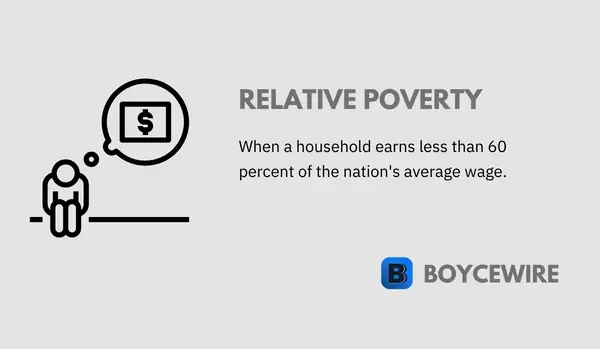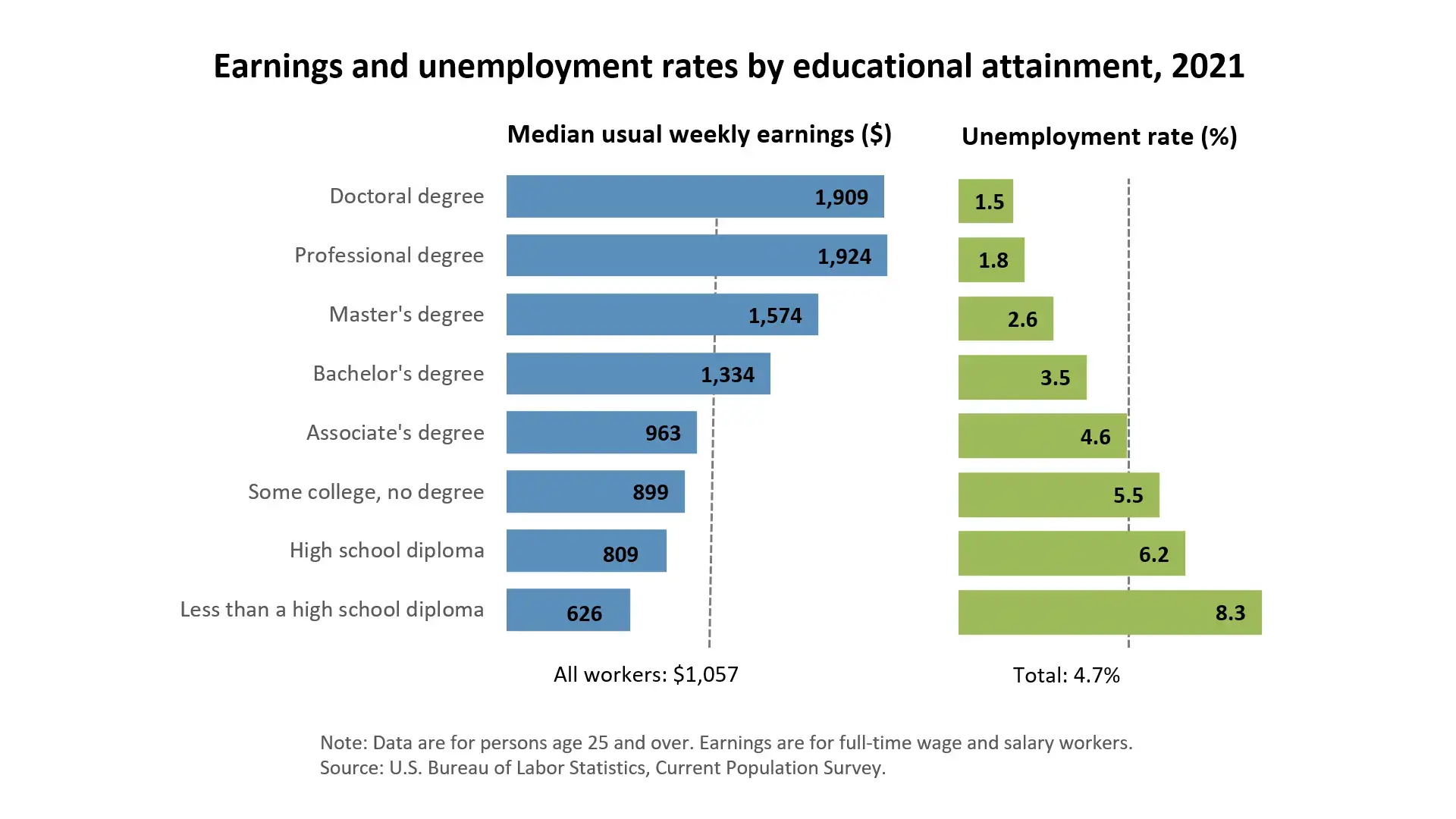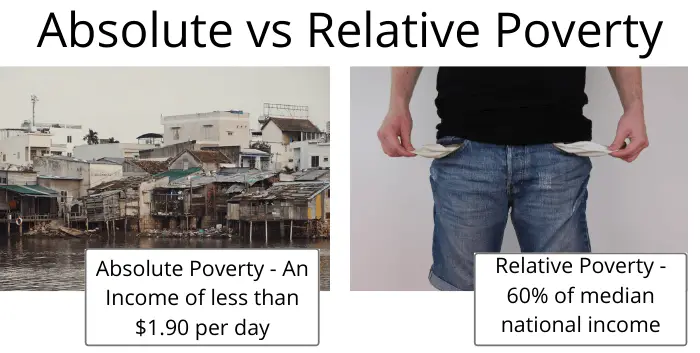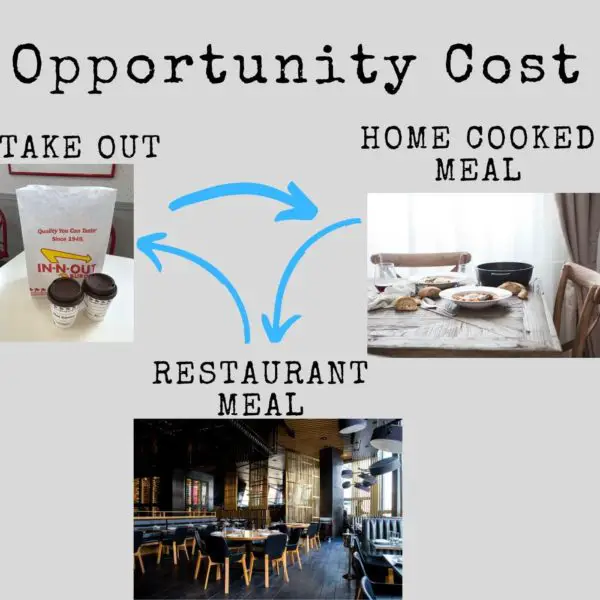Relative Poverty: Definition, Causes & Example

What is Relative Poverty
Relative Poverty occurs when households earn less than 60 percent of the average wage. This means that they have an income, but are unable to buy anything but basics.
Although those in relative poverty may still be able to afford food and drink, they may face social exclusion. For example, some kids may not be able to afford to go to the cinema with their friends. They might not have the same games consoles, or, they may not be able to go on school trips.
The concept of relative poverty is not that people are struggling with survival, but rather, struggle with social inclusion. Humans are social animals and rely on social interaction. By having a low level of income, people are often excluded from social activities such as football games, the cinema, or meals out.
Key Points
- People fall into relative poverty when their income is less than 60 percent of the national average
- It differs from absolute poverty in that is looks at the nation as a comparison.
- Relative poverty is universal by nature in the fact that there is always going to be someone earning less than 60 percent of the nation average.
The term ‘relative poverty’ means that those individuals are in poverty relative to that of the nation. They are not afforded the same luxuries as others such as broadband or the latest iPhone.
This type of poverty can essentially change in line with the economy. For instance, if incomes are rising rapidly in the middle class, it might push more people into relative poverty if lower incomes don’t keep pace.
Causes of Relative Poverty
Relative poverty is when individuals live on an income that is less than 60 percent of the average wage. For example, the average annual salary in the US was $64,140 in 2021. So anyone earning under $32,070 per year would fall into ‘relative poverty’.
When looking at the causes of relative poverty, the main areas are where the lower wages fail to keep up. Perhaps the average wage is increasing rapidly, but lower wages are not. Some examples are highlighted below:
1. Unequal Wage Growth
When wages at the high end of the pay spectrum increase at a faster rate than those at the lower end, we see a widening wage disparity. This is because the more those at the top get paid, the higher it increases the national average wage.
For example, those in the top 20 percent of incomes may receive an increase of 10 percent. However, if those in the bottom 20 percent receive an increase of only one percent, the average is likely to move upwards. Therefore, with the average wage increasing, more people are likely to fall into relative poverty.
2. Artificial Intelligence
One of the benefits of artificial intelligence is that it reduces the amount of labor a firm needs to run its operations. As labor is one of the biggest expenditures for business, this creates a huge cost benefit.
The downside is that in can create huge economic disruption, but also put people out of jobs. Jobs which may pay a decent wage that pulls people out of relative poverty.
One notable example is that of manufacturing. Many jobs have been lost not only because of globalization, but also the increase in smart technology that can do the exact same tasks as a human.
Furthermore, such technology has become a competitor, helping to push and suppress wage growth. Companies can choose to invest heavily in technology, but it’s a large investment. Employees might be cheaper in the short-term. Yet on higher wages, that opportunity cost changes in favor of technology.
3. Lack of Education
Due to a lack of education, individuals often have a more difficult time finding higher paying employment. Often jobs require a certain level of qualifications whether it’s a high school diploma or a college degree. Without such, the barrier to entry on higher paying jobs is that much greater.
As seen by the chart below, those with higher levels of education earn significantly more. For example, those with a doctoral degree earn roughly $1,909 per month. Compare this with those without a high school diploma, who earn roughly $626 per month. This puts them within a greater risk of falling into relative poverty.

Source: U.S. Bureau of Labor Statistics
4. Globalization
Over the last thirty years or so, globalization has led to many benefits, but also significant levels of economic disruption. It has led to the offshoring of many jobs, particularly in manufacturing. What this has done is put millions of workers out of their jobs. Many of whom have been in the same industry for 30 or 40 years.
As workers lose their jobs to international competition, it makes it difficult to transition into an equally well-paid job. For example, a factory worker may be on $50,000 per year having worked in the industry for 30 years of their life. Due to globalization, their job is now being shipped off to China. Their skills lie in manufacturing, so to transition into the booming tech industry is difficult. This creates a huge disruption and could cause them to fall into relative poverty.
5. Poor Infrastructure
Living in a city, it is easy to take the infrastructure for granted. There are roads and public transport is easily accessible. The issue is for those who live in more rural areas where roads are not so developed, with little or infrequent public transport services.
Those who live in rural areas can find themselves in a catch 22 situation. It can prove expensive to travel or move to a city. However, higher paid jobs are generally located in such areas.
City centers are extremely expensive places to live which itself is a prohibiting factor. However, it is the infrastructure that makes it both difficult and expensive to get in which helps cause relative poverty. This is because on the outskirts, where it is more affordable, transport is often infrequent, unreliable, or non-existent.
6. Family Socio-Economic Status
Those who are born into relative poverty are at a higher risk of continuing in poverty into adulthood. This is due to a number of factors. Low socio-economic groups tend to live in more deprived areas with lower quality public services such as education and healthcare.
For children growing up, they may not have the same access to educational materials. This might range from the internet to books to private tutoring. So they are already at a disadvantage at a young age.
7. Poor Health
Poor health can affect people in a number of ways. Some may have a relative in need of care, so need to take time off or cut back on their hours. Others may find themselves in need of care themselves. Unfortunately, this might put a strain on their job prospects and limit their earning potential.
There may also be mental health issues which prevent people from their normal daily activities. They may lose their job as a result, thereby pushing them into poverty.
Relative Poverty Example
An individual falls into relative poverty if they are earning less than 60 percent of the average national income. For example, in the United States, the national average income in 2021 was $64,140. This means that anyone living on a wage of less than $38,484 would fall into ‘relative poverty’.
Those who are on a minimum wage working an average 37.5 hour week would fall into this category. Even those who are on $15 an hour would be on roughly $29,000 per year – which is less than the criteria for relative poverty.
This means that those earning under the threshold of $38,484 are unable to afford the same luxuries as the average citizen. In the U.S. this might mean a smaller fridge, a second-hand motor vehicle, and outdated technology.
Whilst most third world nations would hardly see it as being impoverished, those who are in relative poverty can find themselves facing social exclusion. This can range from sporting events to nights out. Due to the lack of income, such luxuries cannot be afforded.
Relative Poverty vs Absolute Poverty
Relative poverty is defined as anyone who is earning less than 60 percent of the nation’s average income. In other words, it looks at whether people are in poverty relative to that of the average citizen.
By contrast, absolute poverty is where people are unable to meet basic needs such as food, water, and shelter. The World Bank defines this as anybody who is earning less than $1.90 per day using Purchasing Power Parity.

Therefore, the main difference between absolute and relative poverty is that of existential versus that of social inclusion. According to Maslow’s hierarchy of needs, physical needs such as food, water, and shelter form the very foundations of human survival. For those unable to obtain these, they fall into absolute poverty.
It is at the next stages such as that of safety and loving and belonging by which people fall into relative poverty. According to Maslow, this is where people need things like friendships, intimacy, a sense of connection, and secure employment. When people have low levels of income, it makes these needs more difficult to obtain and maintain.
FAQs
People fall into relative poverty when they earn less than 60 percent of the average national income. For example, in the US, the average annual wage in 2021 was $64,140. So anybody earning less than $38,484 will fall into relative poverty. This is because they face poverty in relation to the rest of the country. As they have a lower level of income by comparison, they face material depravation. However, this is only in comparison to the rest of the nation.
The main difference between relative and absolute poverty is that relative poverty looks at income relative to that of the nation. Those who earn less than 60 percent of the national average income fall into this bracket. Yet absolute poverty is a complete absence of basic needs such as food and water. Whilst those who live in relative poverty may be able to eat, drink and have shelter – those in absolute poverty barely has access to those core human needs.
When looking at poverty, it is easy to think of those who can barely eat and have to walk miles upon miles just for water. The generic view of impoverished African nations may spring to mind. However, relative poverty is very different to this viewpoint. It is essentially a comparison against nation peers. This is because it looks at those earning less than 60 percent of the nation average income. Anyone who earns less than this fall into the bracket of ‘relative poverty’. That is to say that they have material deprevation vis a vis the rest of the population. We can also look at it as ‘modern day poverty’, or, ‘developed world poverty’.
About Paul
Paul Boyce is an economics editor with over 10 years experience in the industry. Currently working as a consultant within the financial services sector, Paul is the CEO and chief editor of BoyceWire. He has written publications for FEE, the Mises Institute, and many others.

Further Reading
 Bull Market - A bull market is a financial market where prices of securities are generally rising, indicating positive investor sentiment and a…
Bull Market - A bull market is a financial market where prices of securities are generally rising, indicating positive investor sentiment and a…  Opportunity Cost: What it is, Types & Examples - Opportunity cost is the price we pay to take one action over another.
Opportunity Cost: What it is, Types & Examples - Opportunity cost is the price we pay to take one action over another.  Confidence Interval - A confidence interval is a range of values that provides an estimated range of plausible values for a population parameter,…
Confidence Interval - A confidence interval is a range of values that provides an estimated range of plausible values for a population parameter,… 